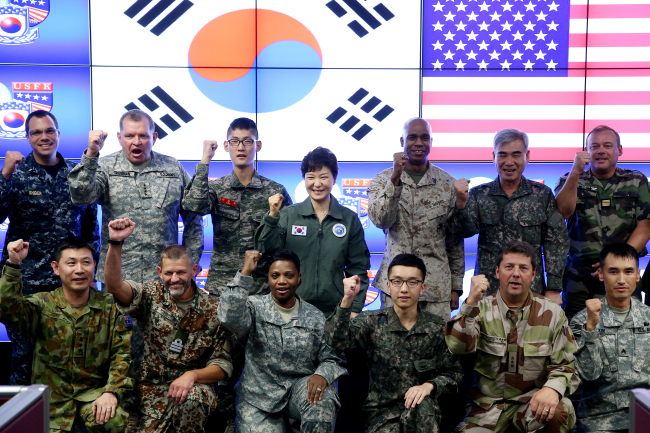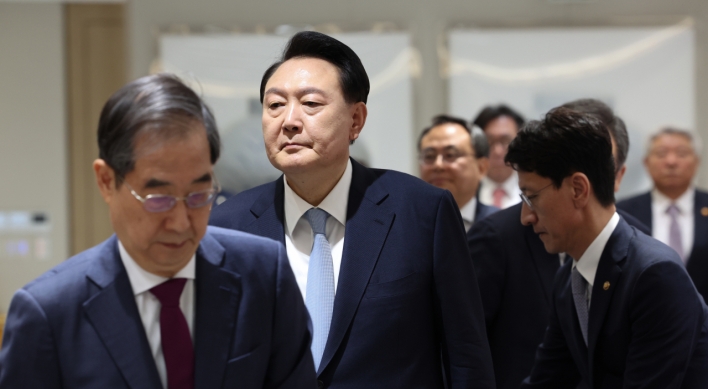Hurdles lie ahead for Korea-U.S. alliance
Experts say allies should tackle difficulties based on mutual trust
By Korea HeraldPublished : Aug. 28, 2013 - 20:30
This is the third in a series of articles to mark the 60th anniversary of the South Korea-U.S. alliance. ― Ed.
The South Korea-U.S. alliance faces daunting tasks to maintain robust deterrence against North Korea and reshape itself in line with the changing contours of regional and global security.
Over the last six decades, the alliance has successfully fulfilled its foremost priority of peninsular defense. Now, in the face of an array of new tasks including the transfer of wartime operational control, the two countries are exploring best ways to tackle them and make the alliance relevant in the 21st century.
“As Presidents Park Geun-hye and Barack Obama vowed to pursue a comprehensive, strategic alliance during their summit in May, the allies should marshal their wisdom, based on mutual trust, to tackle the tasks in a future-oriented manner,” said Kim Yeoul-soo, a security expert at Sungshin Women’s University.
Pending issues range from negotiations over Seoul’s share of the cost of keeping 28,500 U.S. troops here, to mapping out new war plans in tune with the OPCON transfer, and forging a joint vision of the alliance that defines and props up mutual strategic interests in the shifting environments including China’s rise.
The South Korea-U.S. alliance faces daunting tasks to maintain robust deterrence against North Korea and reshape itself in line with the changing contours of regional and global security.
Over the last six decades, the alliance has successfully fulfilled its foremost priority of peninsular defense. Now, in the face of an array of new tasks including the transfer of wartime operational control, the two countries are exploring best ways to tackle them and make the alliance relevant in the 21st century.
“As Presidents Park Geun-hye and Barack Obama vowed to pursue a comprehensive, strategic alliance during their summit in May, the allies should marshal their wisdom, based on mutual trust, to tackle the tasks in a future-oriented manner,” said Kim Yeoul-soo, a security expert at Sungshin Women’s University.
Pending issues range from negotiations over Seoul’s share of the cost of keeping 28,500 U.S. troops here, to mapping out new war plans in tune with the OPCON transfer, and forging a joint vision of the alliance that defines and props up mutual strategic interests in the shifting environments including China’s rise.

China factor
One task of paramount importance to the alliance is to move the partnership forward amid an intensifying Sino-U.S. rivalry. Should the major-power contest for regional primacy escalate, Seoul ― a core Asian ally of the U.S. and crucial economic partner of China ― would be put in an increasingly difficult position.
Beijing apparently believes Washington is seeking to encircle it and offset its military buildup with new operational concepts and strategies. Thus, it appears inclined to think the Seoul-Washington alliance may go against its national interest in the long term, observers noted.
Seoul has been carefully watching the recent moves by Washington to deepen its strategic engagement in the Asia-Pacific emerging as a fulcrum of global power, given that they would affect its strategic interests.
With its “rebalancing” policy toward this region, a financially squeezed Washington has employed a multifaceted approach to maintain its preponderance, which could be challenged by the rise of China.
The U.S. has sought to bolster its military presence; strengthen ties with its allies and partners including the strategically vital Myanmar; and capitalize on multilateral forums such as the East Asia Summit to cement what analysts call “institutionalized” leadership.
These moves have been aggressively pursued as Seoul strives to enhance its strategic partnership with Beijing, which was seen as neglected due to the preceding President Lee Myung-bak administration’s U.S.-centered foreign policy.
For Seoul, China is one of the most crucial partners in terms of trade, tourism and student exchanges. The emerging global power is also a vital stakeholder in Pyongyang’s denuclearization and peninsular reunification.
Pundits say that to a certain degree, South Korea needs to reduce its inordinate reliance on the U.S. and build more trust with China. Yet, tilting to China too much could cause friction in its traditional security ties with the U.S.
Seoul’s deteriorating ties with Tokyo could also be a source of concern facing the Korea-U.S. partnership, given that America’s policy toward the Asia-Pacific basically revolves around alliances with South Korea, Japan and Australia that share the common values of liberty, democracy and market economy.
With Japanese nationalist politicians not fully atoning for their country’s wartime atrocities, Korea’s historical grievances have deepened in recent years, dampening the prospect of practical, future-oriented cooperation in the realm of security.
From Washington’s standpoint, the escalating antagonism between its vital Asian allies poses hurdles to its apparent alliance-based approach to encourage China’s “peaceful rise” and prevent it from becoming a “revisionist” that could destabilize the regional order the U.S. has fostered since the end of World War II in 1945, analysts say.
Another source of concern for the alliance is whether or not President Park’s initiative to build a comprehensive dialogue for peace and prosperity in East Asia will fall in line with Washington’s policy toward this region.
Through the initiative, the Park administration seeks to involve China and other regional players with an aim to build trust in nonpolitical areas first and then in the areas of “high-politics” such as security.
But observers say such multilateralism may pose some challenge to the U.S. policy centering on Asian allies. It may unnerve the U.S. to forge another multilateral institution where China could become more assertive based on its growing military and economic clout, they point out.
OPCON transfer
Another critical pending issue for the alliance is the transfer of wartime operational control and the creation of a new combined command structure ― both of which would reshape the U.S.-led collective defense structure.
The allies have been in consultations for another delay in the OPCON transfer slated for December 2015. In May, Seoul made the request for a review of the timeline in light of Pyongyang’s increasing nuclear threats.
The North is seen edging closer to nuclear armament following a third atomic test in February and a successful launch of a long-range rocket, which is thought to have a range of around 10,000 kilometers ― far enough to hit the U.S. mainland.
“The OPCON transfer would mark the most prominent shift in the 60-year-old history of the alliance as it signals the structural dynamics of the ‘asymmetric’ alliance would change, with Seoul taking a leading wartime role with the U.S. supporting it,” said Park Won-gon, a security expert at Handong Global University.
Seoul officials say Washington appears to be positively looking into the postponement.
Conservatives here have welcomed the talk of another delay, arguing that the OPCON transfer would weaken America’s commitment to peninsular defense and embolden the unpredictable leadership in Pyongyang. They also note the South is not ready yet to retake the OPCON as it seriously lacks intelligence and reconnaissance assets crucial for the combat decisions.
Opponents of the delay argue that, commensurate with its economic and diplomatic standings on the world stage, South Korea should be able to defend itself on its own as quickly as possible.
During their summit in May, presidents Park and Obama shared the view that the allies would prepare for and implement the OPCON handover in a direction that would strengthen combined defense capabilities.
The allies are expected to decide on whether to postpone the transfer during their high-level Security Consultative Meeting to be held in October in Seoul.
In tune with the preparations for the transfer, Seoul and Washington have also discussed their militaries’ new command structure.
The allies were to dissolve their Combined Forces Command following the transfer and create a military coordination system. But their militaries have agreed to virtually retain the core CFC structure as they concur their troops operating under separate commands would impede wartime operational efficiency.
Under the tentative agreement, a four-star Korean general is to head the Combined Theater Command ― the envisioned command structure ― while a U.S. general will become its deputy chief.
This deal, however, is far from completion as it has yet to be endorsed by the countries’ legislatures and presidents. Some observers also cast doubts over whether the U.S. would easily allow its forces to come under the operational control of a foreign commander.
The OPCON transfer and subsequent operational changes also call for new joint war plans. The allies have been working on crafting OPLAN 5015, which will replace the existing OPLAN 5027 centering on responses to an all-out war on the peninsula.
Under OPLAN 5027, the U.S. would dispatch its 690,000 troops to the peninsula and mobilize 160 military vessels and 2,500 aircraft within 90 days of the outbreak of a war. But this Cold War-era plan has become outdated and irrelevant considering a string of factors such as the U.S. decision to reduce its ground troops including marines.
OPLAN 5015 is expected to embrace new war-fighting concepts Washington has been developing with a particular emphasis on aerial and naval assets. This is why Seoul needs to keep track of U.S. policy shifts, analysts say.
Burden-sharing
The allies have been in negotiations over Seoul’s share of the cost for the upkeep of 28,500 U.S. troops here as the current “Special Measures Agreement” governing it expires at the end of this year.
Negotiations have been more difficult as the U.S. grappling with massive spending cuts has demanded an increase in Seoul’s share of the cost. Washington is said to have demanded Seoul increase its share to 50 percent from the current 42 percent.
By the third round of talks last week, the two sides still failed to narrow their differences. The negotiations are to resume next month.
Seoul has called on Washington to use its “burden-sharing” contribution strictly for mutually agreed-upon purposes and show more transparency on where the money has been spent.
A major bone of contention is the U.S. has used part of the money it receives from Seoul for its project to relocate the Second Infantry Division to Pyeongtaek, south of Seoul, rather than using its own budget allocated for that purpose.
Experts said the allies should seek a “win-win” solution to ensure the robust alliance against increasing North Korean threats. They also warned against the possibility of the crucial security issue descending into an emotional, political war of nerves.
Since 1991, Seoul has shouldered partial costs under the SMA for Korean civilians hired by the USFK; the construction of military facilities to maintain the allies’ readiness; the combined defense improvement project; and other logistical support.
Seoul’s burden-sharing, which was 812.5 billion won ($728 million) in 2011 and 836.1 billion won last year, amounts to 869 billion won this year with analysts’ projections for 2014 hovering around 1 trillion won.
Apart from these issues, the allies also have a host of challenging tasks including a revision of a bilateral civilian nuclear energy pact. They have extended by two years the 40-year-old pact, which was to expire next March.
Seoul has sought to revise the pact to be able to reprocess spent fuel and produce low-enriched uranium ― two critical steps for more efficient use of nuclear energy, which are banned under the current pact.
But Washington was opposed to an amendment that could hurt its global nonproliferation initiatives on the grounds that reprocessing could lead to the production of weapons-grade fissile materials.
By Song Sang-ho (sshluck@heraldcorp.com)
-
Articles by Korea Herald







![[KH Explains] How should Korea adjust its trade defenses against Chinese EVs?](http://res.heraldm.com/phpwas/restmb_idxmake.php?idx=644&simg=/content/image/2024/04/15/20240415050562_0.jpg&u=20240415144419)











